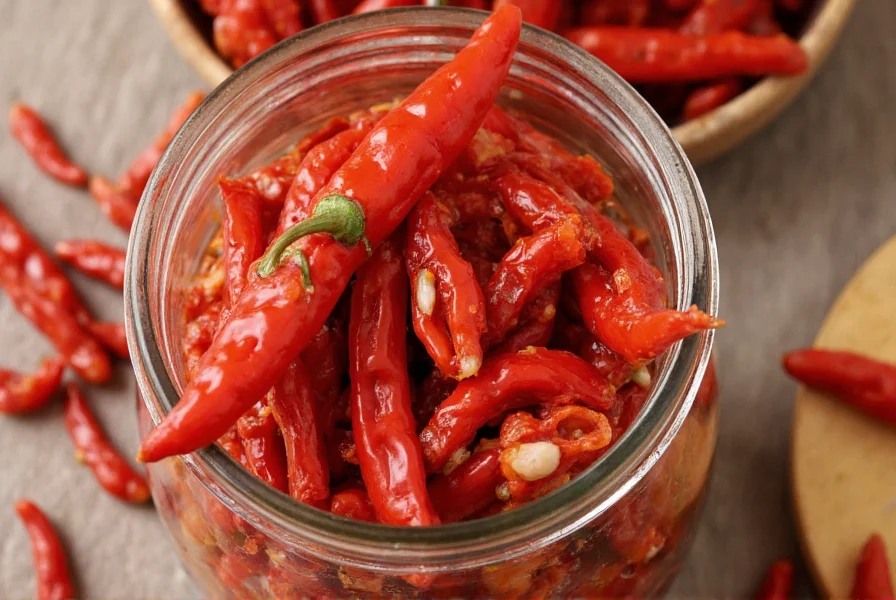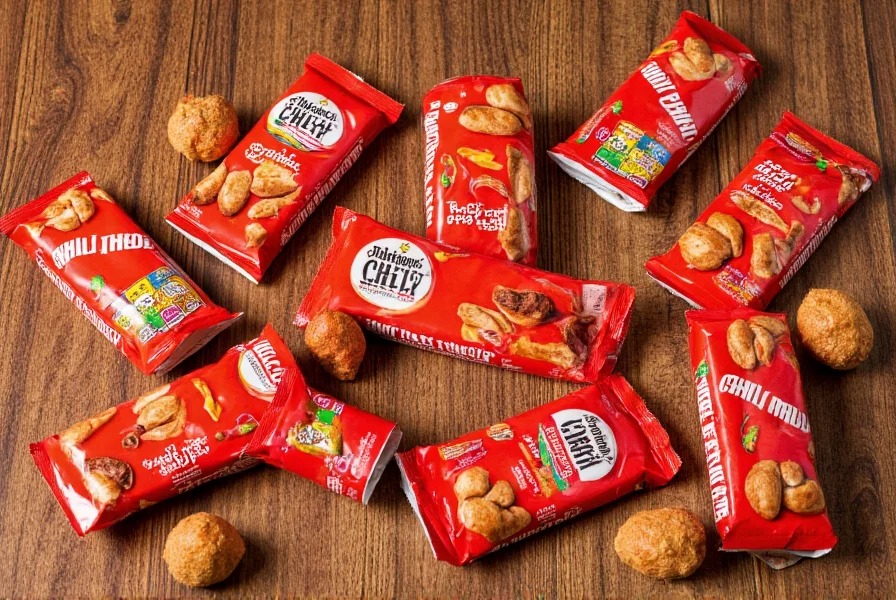Originating from Chinese cuisine, particularly the Sichuan province, chili crisp has evolved from a regional specialty to a global pantry staple. This complex condiment combines the fiery kick of dried chilies with the savory depth of fried aromatics, creating a multi-dimensional flavor profile that enhances virtually any dish.
The Origins and Evolution of Chili Crisp
Chili crisp traces its roots to Chinese home cooking traditions where resourceful cooks would preserve excess chilies by frying them in oil with aromatics. The Sichuan region, renowned for its bold, numbing, and spicy flavors, developed distinctive versions incorporating local ingredients like Sichuan peppercorns. While traditional recipes varied by household, the basic technique remained consistent: slowly infusing oil with dried chilies and aromatics until the solids became crispy.
The modern commercial version gained international prominence through brands like Lao Gan Ma, which began mass production in the 1990s. What started as a humble Chinese condiment has since exploded in popularity across Western markets, with numerous artisanal producers creating their own interpretations while maintaining the essential crunchy texture that defines authentic chili crisp.
Key Ingredients and Flavor Profile
Authentic chili crisp contains several essential components that work together to create its signature taste and texture:
| Component | Common Ingredients | Flavor Contribution |
|---|---|---|
| Base Oil | Vegetable, peanut, or sesame oil | Carries flavors and creates smooth mouthfeel |
| Dried Chilies | Arbol, Tien Tien, or Sichuan varieties | Provides heat and smoky depth |
| Aromatics | Fried garlic, shallots, onions | Creates savory umami and crunch |
| Spices | Sichuan peppercorns, star anise, cinnamon | Adds complexity and subtle numbing sensation |
| Seasonings | Soy sauce, fermented beans, sugar | Enhances overall flavor balance |
The magic of chili crisp lies in its textural contrast—crispy fried bits suspended in flavorful oil. Unlike smooth chili oils, the crunchy components provide both visual appeal and satisfying mouthfeel. The heat level varies by brand but typically ranges from moderate to spicy, always balanced with savory, umami elements that prevent it from being one-dimensionally hot.

How Chili Crisp Is Made
Traditional chili crisp production involves a careful process that extracts maximum flavor while achieving the perfect texture:
- Oil heating: Neutral oil is heated to precise temperatures (typically 250-300°F) to properly infuse ingredients without burning
- Sequential frying: Ingredients are added in stages based on their cooking times—harder items like dried chilies first, followed by aromatics
- Slow cooking: The mixture simmers gently for extended periods (sometimes hours) to develop complex flavors
- Cooling and settling: After cooking, the mixture rests to allow flavors to meld and solids to settle
- Bottling: The finished product is transferred to containers with both oil and crispy solids
Commercial producers maintain strict temperature controls during manufacturing to ensure consistent quality and safety. The best chili crisps achieve a perfect balance where no single ingredient dominates, creating a harmonious blend of heat, crunch, and savory depth.
Popular Brands and Regional Variations
While Lao Gan Ma remains the most widely recognized brand globally, numerous producers now offer distinctive takes on chili crisp:
- Lao Gan Ma - The original mass-market brand featuring fried onions, chilies, and fermented soybeans
- Chili Crisp by Fly By Jing - Artisanal version with Sichuan peppercorns and black truffle
- Chili Crisp by Momofuku - David Chang's interpretation with black garlic and sesame
- Chili Crisp by Sir Kensington's - Western adaptation with accessible heat level
- Chili Crisp by Blue Dragon - UK-based version with balanced spice profile
Regional variations exist across China and Southeast Asia:
- Sichuan style: Features prominent Sichuan peppercorns creating the characteristic "ma la" (numbing-spicy) sensation
- Guizhou style: Often includes fermented fish sauce for additional umami depth
- Yunnan style: May incorporate wild mushrooms and local chilies
- Southeast Asian adaptations: Frequently include shrimp or fish sauce for extra savory notes

How to Use Chili Crisp in Cooking
The versatility of chili crisp makes it one of the most useful condiments in any kitchen. Unlike many hot sauces that serve only as heat sources, chili crisp adds both flavor and texture to dishes. Here are the most popular applications:
As a Finishing Condiment
Add a spoonful to complete dishes just before serving:
- Stir into ramen or noodle soups for instant flavor upgrade
- Top scrambled eggs or fried rice for added dimension
- Drizzle over roasted vegetables to enhance natural sweetness
- Spread on sandwiches or burgers for spicy crunch
As a Cooking Ingredient
Incorporate during cooking to infuse dishes with deep flavor:
- Use as base for stir-fries instead of regular oil
- Mix into marinades for meats or tofu
- Blend with mayonnaise for spicy dipping sauce
- Add to salad dressings for unexpected kick
Creative Applications
Modern chefs and home cooks continue discovering innovative uses for chili crisp:
- Mix with cream cheese for spicy dip
- Stir into macaroni and cheese for adult version
- Add to pizza before baking for spicy crust
- Blend with honey for sweet-spicy glaze
- Stir into ice cream base for adventurous dessert
Storage and Shelf Life
Proper storage maintains chili crisp's quality and safety:
- Store unopened bottles in cool, dark pantry for up to 18 months
- After opening, refrigerate to preserve freshness (most brands)
- Always use clean, dry utensils to prevent contamination
- Quality typically remains optimal for 3-6 months after opening
- Separation of oil is normal—simply stir before using
Unlike many condiments, chili crisp often improves with age as flavors continue to meld. However, discard if you notice mold, off odors, or significant color changes.
Chili Crisp vs. Similar Condiments
Many condiments share similarities with chili crisp but have distinct characteristics:
| Condiment | Texture | Primary Ingredients | Best Uses |
|---|---|---|---|
| Chili Crisp | Crunchy with fried bits | Dried chilies, garlic, shallots, oil, spices | Finishing condiment, cooking base, dipping sauce |
| Chili Oil | Smooth, no solids | Chilies infused in oil | Adding heat without texture, soup base |
| Sriracha | Smooth, liquid | Fermented chilies, vinegar, sugar, garlic | Direct application, mixing into sauces |
| Gochujang | Thick paste | Fermented chilies, glutinous rice, soybeans | Marinades, stews, Korean dishes |
| Sambal Oelek | Chunky but no oil separation | Fresh chilies, vinegar, salt | Indonesian cooking, direct application |
The defining characteristic of chili crisp is its crunchy texture from fried ingredients suspended in oil—setting it apart from smoother alternatives like traditional chili oil or sriracha. This textural element makes it uniquely versatile for both finishing dishes and as a cooking foundation.
Cultural Significance and Global Popularity
What began as a practical Chinese preservation technique has become a global culinary phenomenon. Chili crisp's journey from regional specialty to international staple reflects broader trends in food globalization and the growing appreciation for complex, layered flavors over simple heat.
In Chinese households, chili crisp traditionally served as a way to extend limited pantry ingredients while adding excitement to simple meals. Its popularity in Western markets accelerated during the 2010s as chefs and food enthusiasts discovered its transformative power. The condiment's versatility—equally at home in high-end restaurants and college dorm rooms—has cemented its status as a modern pantry essential.
Food historians note that chili crisp's global success represents a shift in how Western consumers approach international cuisines—not as exotic novelties but as practical, everyday ingredients that enhance familiar dishes. Its ability to elevate simple meals with minimal effort aligns perfectly with contemporary cooking preferences for maximum flavor with minimal complexity.
Frequently Asked Questions
What is the difference between chili crisp and chili oil?
Chili crisp contains fried bits of chili peppers, garlic, and aromatics suspended in oil, providing both heat and crunchy texture. Chili oil is simply oil infused with chili flavor but lacks the solid crunchy components. This textural difference makes chili crisp more versatile as both a finishing condiment and cooking ingredient.
Is chili crisp very spicy?
The heat level varies by brand and recipe, but most chili crisps offer moderate heat balanced with savory, umami flavors. Unlike many hot sauces that focus primarily on heat, chili crisp provides complex flavor beyond just spiciness. Some brands offer mild versions specifically for those sensitive to heat while maintaining the characteristic crunch and flavor profile.
How can I use chili crisp if I'm not good at cooking?
Chili crisp is perfect for beginners because it instantly elevates simple dishes with minimal effort. Just stir a spoonful into instant ramen, scrambled eggs, or plain rice for an immediate flavor upgrade. You can also mix it with store-bought mayonnaise for a quick dipping sauce or drizzle it over takeout for added complexity. No cooking skills required—just add and enjoy.
Does chili crisp need to be refrigerated after opening?
Most commercial chili crisps should be refrigerated after opening to maintain freshness and prevent spoilage, though specific requirements vary by brand. The oil base helps preserve the product, but the fried ingredients can degrade over time at room temperature. Always check the label for storage instructions, and when in doubt, refrigerate opened bottles to maximize shelf life.
Can I make chili crisp at home?
Yes, homemade chili crisp is achievable with basic ingredients and careful temperature control. You'll need dried chilies, garlic, shallots, neutral oil, and optional spices like Sichuan peppercorns. The key is slowly frying ingredients at precise temperatures to extract maximum flavor without burning. While homemade versions lack the commercial consistency of store-bought brands, they allow for complete customization of heat level and flavor profile.











 浙公网安备
33010002000092号
浙公网安备
33010002000092号 浙B2-20120091-4
浙B2-20120091-4